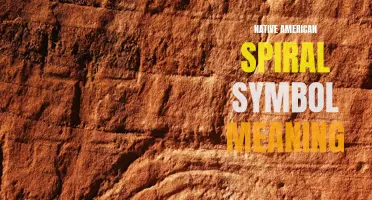
The Manji symbol, also known as the Swastika, is an ancient symbol that has found its place in many different cultures around the world. Despite its association with negativity in modern times, the symbol originally had positive meanings and was widely used as a symbol of good fortune and well-being. In this article, we will delve into the rich history and varied interpretations of the Manji symbol, shedding light on its true meaning and significance.
What You'll Learn
- What is the historical meaning behind the manji symbol?
- How has the manji symbol been used in different cultures?
- Are there any negative connotations associated with the manji symbol?
- How has the meaning of the manji symbol evolved over time?
- How does the manji symbol differ from the swastika symbol used by the Nazis?

What is the historical meaning behind the manji symbol?
The manji symbol, also known as the swastika, is an ancient and widely used symbol that has a diverse range of meanings across different cultures and religions throughout history. While it is most commonly associated with Nazi Germany and the atrocities committed during World War II, its historical meaning extends far beyond this dark chapter of human history.
The manji symbol can be traced back thousands of years and has been found in numerous cultures around the world, including ancient Mesopotamia, India, China, and Native American cultures. In Sanskrit, the word "swastika" means "well-being" or "good fortune," and the symbol is often seen as a representation of prosperity and auspiciousness.
In Hinduism and Buddhism, the manji symbol is a sacred religious symbol and is used to represent divinity and spirituality. It is commonly associated with the sun, as its four arms are thought to resemble the rays of the sun radiating outwards. It is also believed to symbolize the cycle of birth, death, and rebirth, as the arms of the symbol rotate in a clockwise direction, which represents the continuous flow of life.
In many Native American cultures, the manji symbol is seen as a symbol of protection and good luck. It is often used in pottery, textiles, and jewelry to bring positive energy and ward off evil spirits. The symbol is also believed to represent the four elements – earth, air, fire, and water – which are considered to be essential for life.
However, despite its positive historical meaning, the manji symbol has been tarnished by its association with the atrocities committed by the Nazis during World War II. Adolf Hitler and the Nazi party adopted the symbol, reversing its orientation and giving it a new meaning that was filled with hate, violence, and discrimination. This association has overshadowed the symbol's original positive meanings and has made it a deeply sensitive and controversial symbol in many parts of the world.
In light of its historical association with the Nazis, many countries have banned the use of the manji symbol and consider it to be a hate symbol. However, it is important to remember that the symbol predates its Nazi association by thousands of years and has held positive meanings in numerous cultures throughout history.
The manji symbol is a prime example of how the meaning of a symbol can become distorted and tainted by historical events. While it is difficult to separate the symbol from its association with the Nazis, it is crucial to recognize and understand its broader historical meanings to avoid perpetuating ignorance and misunderstanding. By acknowledging its ancient origins and positive connotations, we can strive to appreciate the symbol in its original context and appreciate the diversity and complexity of human history.
Exploring the Deep Symbolism of Woman: Unraveling the Meanings of Strength and Courage
You may want to see also

How has the manji symbol been used in different cultures?
The manji symbol, also known as the swastika, has been used in various cultures around the world for thousands of years. While its association with Nazi Germany in the 20th century has given it negative connotations, it is important to understand that the symbol has a long history predating the rise of the Nazis.
In Hinduism, the manji symbol represents many things, including the sun, prosperity, and good luck. It is considered a sacred symbol in Hindu culture and is often used in religious ceremonies, temples, and decorations. The symbol is also associated with the Hindu god Vishnu and is sometimes depicted on his chest. In Hinduism, the right-facing manji, known as the "sauvastika," is considered auspicious and is commonly used.
In Buddhism, the manji symbol is associated with the Buddha. It is often seen on the chests or palms of Buddha statues, representing the Buddha's footprints. In Buddhism, the symbol is associated with eternal harmony and the endless cycle of birth, death, and rebirth. The left-facing manji, known as the "sauvastika," is commonly used in Buddhist art and represents spiritual awakening and enlightenment.
In Jainism, the manji symbol is associated with the four Tirthankaras, or spiritual leaders, who have achieved enlightenment. Jain temples, scriptures, and religious objects often bear the symbol as a reminder of the faith's teachings.
In Native American cultures, the manji symbol is known as the "whirling log" and is associated with healing and protection. It is often used in traditional Navajo and Hopi art and can be found on pottery, textiles, and sand paintings. The symbol is believed to bring positive energy and ward off evil spirits.
In Celtic cultures, the manji symbol, known as the "gammadion," has been found on ancient artifacts and monuments. It is associated with fertility, continuity, and the cycles of life. The symbol can be seen in Celtic art and is sometimes combined with other Celtic symbols, such as knots and spirals.
While the manji symbol has been used in different cultures throughout history, it is important to differentiate between its various meanings and contexts. While it may be associated with negative imagery due to its misuse by the Nazis, it holds deep spiritual and cultural significance for many other cultures around the world.
The Meaning Behind the RN Symbol and Its Importance in the Medical Field
You may want to see also

Are there any negative connotations associated with the manji symbol?
The manji symbol, also known as the swastika, has a long and complex history that dates back thousands of years. It has been used by various cultures and religions, including Hinduism, Buddhism, and Jainism. In most of these contexts, the symbol represents auspiciousness, good luck, and well-being. However, in recent history, the manji has become synonymous with hate, violence, and Nazi Germany.
The negative connotations associated with the manji symbol are primarily due to its adoption by the Nazi Party during World War II. The swastika was used as the party's emblem and became a symbol of the regime's racist ideology and heinous crimes against humanity. The atrocities committed by the Nazis have forever tainted the manji symbol, causing it to be universally condemned by the majority of people around the world.
The association with the Nazi regime has caused the swastika to be banned in many countries, including Germany itself. It is seen as a hate symbol, and its public display is illegal in countries such as Germany, Austria, Poland, France, and Israel. Even in countries where it is not explicitly banned, the use of the manji symbol is highly stigmatized and considered deeply offensive.
The negative connotations of the manji symbol extend beyond its association with the Nazis. In Western cultures, where the symbol is most commonly recognized as the swastika, it is often seen as a sign of hate and white supremacy. This is partly due to the widespread media coverage and education about the atrocities committed during World War II. As a result, any use of the manji symbol, regardless of its historical or religious significance, is met with strong negative reactions.
However, it is important to note that the manji symbol has a much broader history and significance than its association with the Nazis. In Hinduism, for example, the swastika is considered one of the most sacred symbols and represents prosperity, good fortune, and spirituality. In Buddhism, it is associated with the Buddha's footprints and is a symbol of the Dharma, the teachings of the Buddha.
It is crucial that the negative connotations associated with the manji symbol are understood in their historical and cultural context. While its use as a Nazi symbol cannot be overlooked or downplayed, it is essential to recognize that the symbol has a much older and more positive meaning in many cultures. Ignorance about the symbol's multifaceted history can lead to misconceptions and perpetuation of prejudice and discrimination.
In conclusion, the manji symbol, also known as the swastika, carries significant negative connotations due to its association with the Nazi regime. This association has led to the symbol being universally condemned and banned in many countries. However, it is important to understand that the manji symbol has a history that predates its association with hate and violence. Recognizing the symbol's historical and cultural context is necessary to avoid misunderstandings and promote tolerance and understanding among different cultures and religions.
Decoding the Hidden Meanings Behind Gravity Falls Symbols
You may want to see also

How has the meaning of the manji symbol evolved over time?
The manji symbol, also known as the swastika, is a sacred symbol in various cultures and religions around the world. Its meaning has evolved over time, and its association with Nazi Germany during World War II has significantly impacted its perception in Western societies. However, it is essential to understand the historical context and diverse interpretations surrounding the manji symbol.
Originating in ancient Hinduism, the manji symbol represents good fortune, abundance, and the cycle of life. In Sanskrit, "manji" means "auspicious" or "lucky," and it was commonly used as a decorative motif in temples, homes, and other sacred spaces. In Hinduism, the swastika symbolizes the sun and is associated with several deities, including Ganesha and Vishnu.
The manji symbol spread beyond Hinduism and became prominent in other cultures and religions, including Buddhism, Jainism, and Native American traditions. In Buddhism, it represents the footprints of the Buddha and symbolizes the eternal life cycle, enlightenment, and the eightfold path. The swastika can still be found on Buddhist temples, scriptures, and religious objects in countries like Japan, China, and Korea. Similarly, Jainism associates the manji symbol with sacredness, peace, and the four states of existence.
However, the meaning of the manji symbol drastically changed during the 20th century due to its association with Nazi Germany. Adolf Hitler and the Nazi Party appropriated the swastika as their emblem, distorting its original significance. The Nazi swastika was mirrored diagonally and used as a symbol of Aryan purity and white supremacy, forever tarnishing the manji symbol in the eyes of many.
The atrocities committed by the Nazis during World War II, including the Holocaust, have resulted in the swastika being universally recognized as a symbol of hate, intolerance, and genocide. Its association with Nazism has overshadowed its ancient origins and positive connotations in other cultures.
Nevertheless, it is important to note that the manji symbol still holds its original meaning in Hinduism, Buddhism, and other religions. In these traditions, the swastika continues to be seen as a symbol of auspiciousness, wisdom, and spiritual well-being. It is crucial to respect and acknowledge the diverse interpretations and cultural significance of the manji symbol, while also understanding the immense harm caused by its association with Nazi Germany.
In recent years, efforts have been made to reclaim the swastika's original meaning and separate it from its Nazi connotations. Some religious and cultural organizations advocate for educating the public about the symbol's ancient origins and context. Additionally, initiatives like the Hindu Swastika Global Initiative promote understanding and usage of the manji symbol in its traditional form, detached from its Nazi association.
In conclusion, the meaning of the manji symbol has evolved over time from a symbol of good fortune and cyclic existence to a symbol of hate and genocide due to its association with Nazi Germany. However, it is essential to recognize and respect its original significance in various cultures and religions, understanding that the swastika can carry different meanings depending on its context. By promoting awareness and education, we can foster a more nuanced understanding of this ancient symbol and work towards reclaiming its positive connotations.
The Enchanting Symbolism and Meaning of Pearls
You may want to see also

How does the manji symbol differ from the swastika symbol used by the Nazis?
The manji symbol and the swastika symbol used by the Nazis are two distinct symbols that have vastly different meanings and origins. While they may share a similar appearance, it is essential to understand the historical and cultural contexts in which they are used.
The manji symbol, also known as the "tenkan," is an ancient religious symbol that holds significant cultural and religious relevance in several Eastern religions, including Buddhism, Hinduism, and Jainism. It is a symbol of good fortune, prosperity, and eternity. The word "manji" itself translates to "whirlwind" or "swastika" in Japanese, emphasizing its association with positive energy and cyclic existence.
Visually, the manji symbol appears as a square cross with arms bent at a right angle in a clockwise direction. In Asian cultures, it has been used for thousands of years as a positive and auspicious emblem. Buddhist temples in Japan, for example, often incorporate the manji symbol into their architectural design, signifying peace and harmony.
On the other hand, the swastika symbol that was used by the Nazis during World War II has a vastly different history and meaning. The swastika, derived from the Sanskrit word "svastika," has been a symbol of good luck and well-being in various cultures around the world for over 5,000 years, including in ancient India, Greece, and Native American tribes. It represented the sun, as well as the four cardinal directions, and was generally seen as a positive and auspicious symbol before its association with Nazi Germany.
However, the Nazi party adopted the swastika symbol in the 1920s and radically altered its meaning. Under Adolf Hitler's leadership, the swastika became a symbol of hate, racism, and genocide. The Nazis used the symbol to promote their Aryan supremacist ideology, which excluded and persecuted various ethnic and religious groups, primarily Jews and Romani people. This association with hatred and violence has had a lasting impact on the symbol's reputation and perception worldwide.
In terms of visual appearance, the Nazi swastika and the manji symbol differ slightly. The Nazi swastika is tilted at a 45-degree angle and usually faces in a counter-clockwise direction. It is usually depicted on a white circle within a red background. On the other hand, the manji symbol is often depicted in a square or diamond shape and faces in a clockwise direction. Additionally, the manji symbol is usually used in a different color scheme, such as black or gold, often within a religious or cultural context.
In conclusion, while the manji symbol and the swastika symbol used by the Nazis may share some visual similarities, their meanings and historical contexts are vastly different. The manji symbol represents positive energy, eternity, and good fortune in Eastern religions, while the Nazi swastika has become a symbol of hate and genocide. It is important to understand and respect the cultural and historical significance of these symbols to avoid any misconceptions or misinterpretations.
The Symbolic Meaning of Wheat: Exploring its Significance Across Cultures and Time
You may want to see also
Frequently asked questions
The manji symbol, also known as the swastika, has various meanings depending on different cultures and contexts. In many Eastern religions, such as Buddhism and Hinduism, the manji represents good luck, well-being, and auspiciousness. It is often associated with the sun, and its four arms symbolize the four cardinal directions.
The manji symbol gained negative connotations due to its association with the Nazi regime during World War II. Adolf Hitler adopted a modified version of the symbol, rotating it and reversing its direction. This symbol, known as the Hakenkreuz, became synonymous with hate, racism, and genocide. As a result, the manji symbol is often misunderstood and stigmatized in Western cultures.
While the manji symbol is still used today, particularly in Eastern cultures, its usage is often restricted or approached with caution in Western societies. It is important to distinguish between the original manji symbol, which has positive meanings, and the Nazi Hakenkreuz, which is associated with hate. In some countries, the display of the manji symbol is regulated or banned to prevent any association with Nazi ideology.
Yes, the manji symbol can be seen in various forms of architecture and art across different cultures. In East Asia, it can be found in ancient temples, pagodas, and traditional decorative patterns. In Hindu temples in India, the manji symbol is often included in intricate mandala designs. While its usage may vary, it is important to interpret the manji symbol within its cultural and historical context.
To create awareness and educate others about the true meaning of the manji symbol, it is important to provide accurate information and historical context. Promoting understanding and respect for different cultures and their symbols is essential. Encouraging open dialogue and discussing the symbolism and significance of the manji symbol can help dispel misunderstandings and misconceptions. Additionally, emphasizing the distinction between the original manji symbol and the Nazi Hakenkreuz can help clarify its true meaning.







